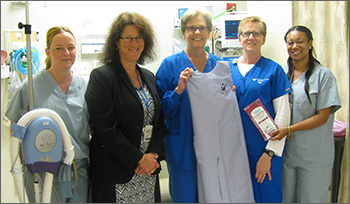
Popular Locations
- Yale New Haven Children's Hospital
- Yale New Haven Hospital - York Street Campus
- Yale New Haven Hospital - Saint Raphael Campus


In Yale New Haven's ongoing efforts to prevent hospital-acquired infections, the battle against surgical site infections includes new protocols, procedures and staff training — along with some unexpectedly simple tools, like stickers.
Teams from different disciplines, including surgeons and staff from Nursing, Anesthesiology, Infection Control, Pharmacy and other specialties, have researched best practices in surgical site infection (SSI) prevention for different categories of surgeries, including transabdominal procedures such as hysterectomies and colon procedures, orthopedic procedures such as hip and knee replacements and spine surgeries, and cesarean sections.
"Surgical site infections are a major safety concern, here and nationwide," said Heidi Rillstone, RN, patient safety coordinator, Perioperative Services. "They can also contribute to pain and additional treatments for patients, as well as longer lengths of stay and hospital readmissions."
Teams in different specialty areas have successfully reduced infections by implementing "SSI bundles" — sets of protocols and procedures for care before, during and after surgery. Many of the bundles share similar components proven to reduce infection risk.
The transabdominal bundle includes using chlorhexidine antibacterial skin wipes before surgery, standardizing the antibiotics used during surgery and using special warming gowns or blankets for patients before and during surgery. The team designed a "do not remove until " sticker that indicates when the dressing placed over a surgical site can be safely removed.
Warming before and during surgery, chlorhexdine wipes and other measures were successfully implemented for orthopedic procedures years ago, said Michelle Whitbread, infection preventionist, Quality Improvement Support Services. The orthopedic team has focused recent efforts on pre-surgery care, including screening patients for Staphylococcus aureus bacteria — a common SSI cause — and testing a nasal antibacterial solution for patients immediately before surgery, among other measures.
The Labor and Birth patient safety committee has also implemented pre-hospital procedures — including antibacterial wipes patients use before coming to the hospital, said Christian Pettker, MD, medical director, Labor and Birth and Maternal Special Care units. Other protocols that have helped reduce SSIs include OR and patient warming, skin preparation, requirements for surgical team attire in the OR and sutures, rather than staples, to close incisions.
"For any type of surgery, preventing SSIs requires multiple interventions at different stages of the patient's care — before the patient comes to the hospital, right before surgery begins, during the procedure and postoperatively," Whitbread said. "It's a lot of steps, but all are essential to keeping our patients safe."